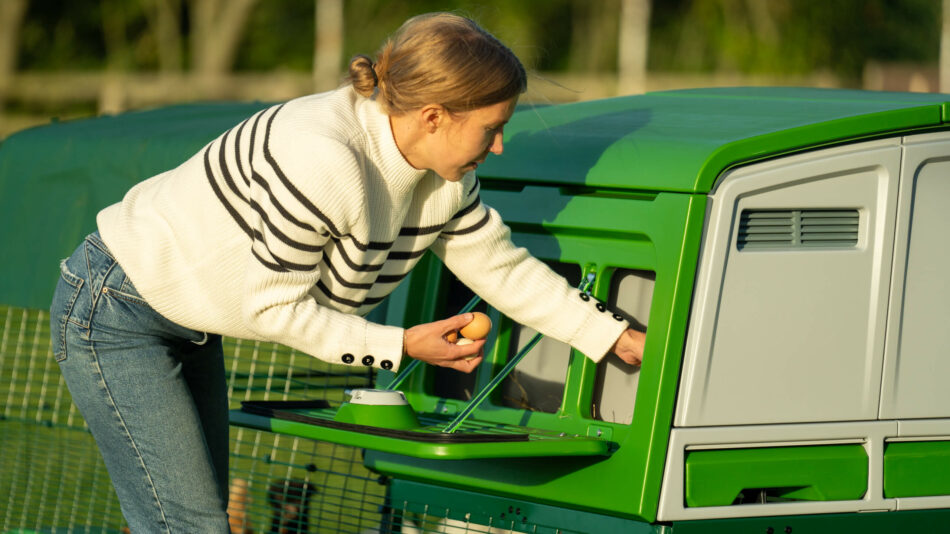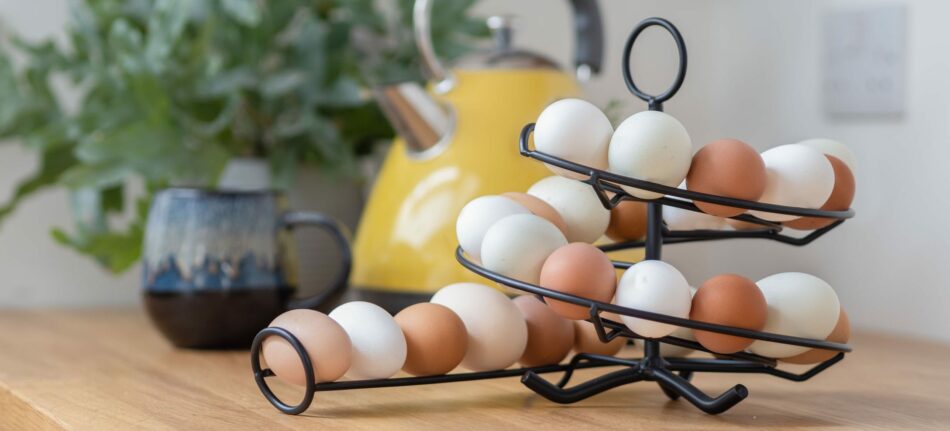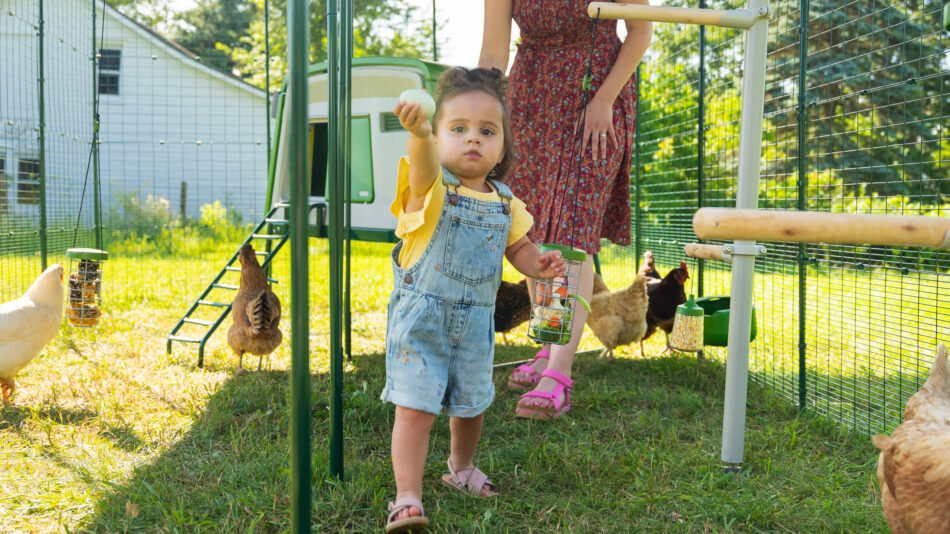What do your chickens’ eggs say about their health?
Chickens are a pet that give a return on your investment. Not just through a rewarding emotional bond that is experienced between pet and owner (though certainly that too), but through tangible goods: delicious, nutritious, and gorgeous eggs. The nutritional makeup of an egg alone is amazing, but you can also analyze your chickens’ eggs to get a glimpse into their overall health. What do your hens’ eggs say about their health? From laying frequency, egg size, shape, color, and texture — here’s what your daily gathering can tell you about your flock.
Nutritional value of eggs
Healthy hens lay healthy eggs, and it’s hard to beat their nutritional value. On average, one chicken egg contains just 75 calories, but 5 grams of protein. Along with milk, eggs hold the “gold standard” for biological protein value. Eggs also contain vitamins and minerals essential to human health. And they’re versatile too — there are so many different ways to enjoy eggs, either on their own or as part of a recipe. When your hens are laying healthy looking eggs on the regular, it means they’re receiving proper nutrition and feel safe in the nesting area of their chicken coop.
When you aren’t collecting these nutritional offerings as often as usual, or if your hens’ eggs begin to look or feel unusual, there may be underlying issues at play. From illness to stress, here are some ways your flock’s eggs can hint at a health concern.
Change in egg laying frequency
How often do hens lay eggs? The answer is a bit more complex than the common notion of “an egg a day,” and many factors are taken into account when determining what is normal egg production for a hen. Breed, age, health, and time of year all affect how many eggs chickens lay.
Among the many different chicken breeds that are considered good layers (those that can lay upwards of 300 eggs per year), some well known egg producers include:
Ornamental and smaller chicken breeds lay less frequently, with some only laying a few eggs each month.
Hens that are not feeling well, or are malnourished will lay less frequently. Flock discord, inadequate nutrition, and overcrowding are a handful of stressors that can take a toll on egg production. Make sure your hens have access to clean water and quality layer pellets at all times to ensure they’re getting the calories and nourishment they need. Adding scratch grains, chicken treats, and healthy kitchen scraps or safe foods from the garden to their diet will also give hens a nutritional boost.
Hens will inevitably lay less, or stop laying eggs altogether in the winter. A hen’s ovulation cycle is based on daylight hours, so once the days shorten, you can expect egg production to slow down. This is a hen’s natural reaction to the changing seasons as they prepare to reallocate energy to keep warm instead of laying eggs. Your hens will resume a normal laying schedule closer to spring, as days grow longer.
Molting season
Another annual reason for a decrease in egg production is a process called “molting.” Molting is the process of shedding old feathers and regrowing new ones to replace them. This process also occurs in preparation for winter – so as the days grow shorter, your hens will begin to lose their dingy feathers in favor of new, more dense feathers to keep them warm. The result is a beautiful, vibrant new outfit of feathers for your hens – but less eggs for you to gather. Molting takes a lot of energy, so expect your chickens to be on “lay-cation” for 8-16 weeks. Helping your hens through their molt will better prepare your flock for their annual feather-renewal.
Eggs of a different color
Did you know that chickens lay eggs in several different colors? You’ve probably seen white and brown eggs, but some chickens can lay eggs in shades of green, blue, and even pink. So, what causes such a variety of colors?
Genetics determine what color eggs a hen will lay. Some breeds of chickens have a standard color you can expect from them. For example, you can count on Leghorns to lay white eggs, Orpingtons lay brown eggs, and Ameraucanas lay blue eggs. But different shades such as olive are the result of a hybrid hen – a hen bred from a combination of blue and brown egg genes. For example, if you bred an Orpington (brown egg genetics) rooster with an Ameraucana (blue egg genetics) hen, the result would be an “olive egger” hen that would lay green eggs. Egg color should be consistent with the hen laying them, and different colored eggs are not a cause for concern unless a hen suddenly starts laying a different shade from what is normal for them.
All eggs begin with a white shell, but the hen laying the egg adds a pigment to them as they make their way to be laid. This pigment only colors the shell, and does not penetrate the membrane.
Pro tip: you can get an idea of the color eggs a hen lays by looking at their earlobes. Hens with white earlobes will lay white eggs, and hens with red earlobes will lay brown eggs. This technique is not as accurate for pigmented eggs (blue, green or pink), as hybrid-chickens will have a variety of colors to their earlobes. Still, it’s fun to try this prediction-test with your flock.
Double yolks
In a rare, but completely normal phenomenon, chickens can lay eggs with two yolks inside. If fertilized and incubated or kept under a broody hen, double-yolked eggs can hatch twin chicks – but it’s more common for only one embryo to fully develop.
If you crack one of your chickens’ eggs and start seeing double, it’s the result of the hen releasing two yolks at the same time during ovulation — which then become encapsulated within one shell. It’s more common for newly-matured hens to lay double-yolked eggs, as their bodies are adjusting to ovulation. Laying eggs with two yolks can also be genetic, and hens may continue to do so for the duration of their egg-laying career.
Thin shell, or no shell at all
Have you ever collected eggs, only to find yourself flabbergasted by a squishy egg? Soft-shelled eggs feel like partially filled water balloons and can be very disconcerting to find in the nesting box. These strange, spongy eggs are actually laid without the presence of the shell; only the membrane. This most often occurs with high-producing hens, when their bodies simply cannot keep up with yolk production. Oftentimes they will lay a fully-formed egg, then lay a shell-less egg a few hours later.
The other most common reason for eggs having thin or missing shells is inadequate calcium in their diet. Warning signs leading up to shell-less eggs can be thinner shells, so take note if your hens’ eggs are suddenly much easier to crack, or if you find broken eggs in the nesting box. A lot of calcium is required to “fully clothe” a yolk, so be sure to feed quality layer pellets that contain added calcium. If you notice thinner shells or “naked” eggs, supplement your hens’ feed with crushed oyster shells or other chicken calcium supplements. You can also save egg shells after cracking them to crush or grind up and sprinkle on top of your hens’ feed. Be sure not to offer shells that have not been broken down into smaller pieces, as chickens can acquire a taste for eggs and will actually eat them straight out of the nesting box.
Boost your hens’ shell-producing ability with chicken supplements to ensure they have all of the vitamins and minerals they need. As an added bonus, supplements such as omega-3 fed to your chickens pass through to their eggs– and then to you when you eat them.
Looks can be deceiving
Sometimes an egg might look a little off, but it may be hard to place why. These common sights are usually no cause for concern unless they become the new normal.
Why is there blood on my chicken’s egg?
While it may look concerning, blood smears on an eggshell usually indicate that it came from a new layer (pullet). This issue should resolve on its own after the first few weeks of laying.
Why are my hen’s eggs long and skinny?
Also more common in pullets just starting to lay, eggs can sometimes take on an awkward shape or appearance. Young hens will often start laying smaller, elongated eggs that look almost pointed. If elongated eggs appear suddenly and regularly in mature hens, notify your veterinarian, as this could indicate illness.
Why do my chickens’ eggs have bumps, divots or ridges?
The texture of eggs is an excellent sign of potential nutritional deficiencies or stress in your flock. Any hens’ consistently laying eggs that do not have a round, smooth shell, are experiencing either stress or malnutrition. Make sure your chickens’ feed has adequate levels of protein, calcium, and vitamins and minerals. Overcrowding is often a source of stress for chickens, so give them plenty of room in a walk in chicken run or an area of chicken fencing during the day, and adequate space in their chicken coop at night.
Why is there a chalky film on my hens’ eggs?
An abundance of calcium in a flock’s diet can cause eggs to be laid with a chalky or waxy appearance. Brown eggs may take on a pink hue from this excess calcium, or you may see flecks of white on darker colored eggs. To correct this, scale back on calcium supplements until the eggs take on a normal appearance once again. If the film persists but only with one or two hens, it’s more likely that you have a couple of hens that produce a thicker bloom (cuticle) layer than others. In this case, the waxy film is perfectly normal, and even beneficial.
Even though they may not look as appealing as “normal” eggs, most unusual looking eggs are safe to eat. Most of the time deformities lie within the shell only, with the inside of the egg remaining unaffected. Any eggs that have sustained damage to their shell should be discarded, as bacteria will have had the chance to enter through the compromised shell.
Chicken checks
Check-in with your hens by doing regular chicken health checks to make sure everyone is in tip-top shape. Look for any new or unusual signs or symptoms in your chickens during this health check. It’s also a good idea to have an extra Eglu Go Chicken Coop setup for quarantining sick or new flock members.
Unusual eggs can sometimes point to illness. If you notice your chickens having symptoms accompanying irregular egg laying, or the prolonged presence of abnormal-looking eggs, it’s time to contact your veterinarian.
Omlet and your hens’ health
Eggs can tell you a lot about your hens’ health — but so can their appearance and activity level. That’s why we’ve made it easier and more enjoyable than ever to keep your flock fit and healthy. Our extra large chicken coops give everyone in your flock plenty of space to lay and roost, and our walk in chicken runs can be expanded to any dimension of your choosing — giving you plenty of space to spend time with them. Round out your setup with a customizable PoleTree Chicken Perch, and your hens will have the ideal space to keep them healthy and happy for years to come. With our ingeniously designed products, you’ll always know what your flock is up to, and that every part of their home has been carefully crafted for their health and happiness.
This entry was posted in Chickens



